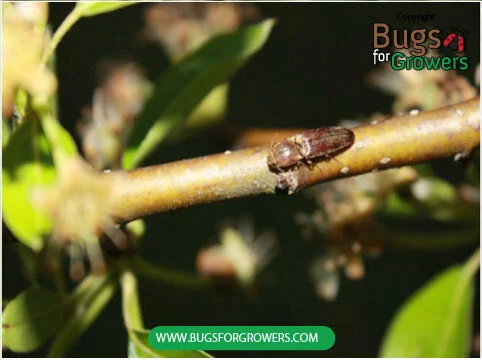What are click beetles and wireworms?
Click beetles are small and brown to black colored insects (Photo 1) that generally feed on nectar, pollen, flowers (Photo 2) and soft bodied insects like aphids. They are named as clicking beetles because they produce clicking sound to get away from predators. Life cycle of click beetles contain eggs, larvae (wireworms), pupae and adults. Wireworms look like mealworms, creamy in color with hard body skeleton and are known to live as larvae in the soil for 4 years before they become pupae. Adults of click beetles emerge from pupae within a week of pupation. Click beetle adults do not cause any economic damage to plants but their larvae are called wireworms that cause serious damage to many crops including beans, onions, peas, potatoes, sugar and wheat. Wireworms generally feed on the roots but they can also feed on seeds of many host plants.
Photo 1. An adult of click beetle
Photo 2. Click beetle feeding pear pollen
Biological control of wireworms?
Since there are no either chemical or biological pesticides are recommended for the control of wireworms, Sandhi et al. (2020) tested the efficacy of different species of entomopathogenic nematodes including Steinernema carpocapsae, Steinernema riobrave, Steinernema rarum and Heterorhabditis bacteriophora against sugarbeet wireworms, Limonius californicus under laboratory conditions. According to these researchers, two species of entomopathogenic nematodes including Steinernema carpocapsae (Photo 3) and Steinernema riobrave were better than other species of entomopathogenic nematodes causing mortality of sugarbeet wireworms. These researchers have also suggested that Steinernema carpocapsae and Steinernema riobrave have potential to be used as best biological control agents for controlling wireworms infesting wheat crops. Since wireworms and pupae of click beetles live in the soil, they can be easily targeted by application of beneficial nematodes.
Photo 3. Infective juveniles of beneficial entomopathogenic Steinernema carpocapsae nematode.
Reference:
Sandhi, R. K., Shapiro-Ilan, D., Sharma, A. and Reddy, G.V. P. 2020. Efficacy of entomopathogenic nematodes against the sugarbeet wireworm, Limonius californicus (Mannerheim) (Coleoptera: Elateridae). Biological Control 143: Article number 104190. DOI: 10.1016/j.biocontrol.2020.104190.


